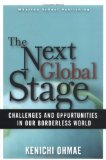The Next Global Stage Book Review
The Next Global Stage-Challenges and Opportunities in Our Borderless World
Author: Kenichi Ohmae
Publisher: Wharton School Publishing March 2005
Hardcover: 312 pages
In some ways, I was a little disappointed with this publication, yet in many others I was pleased to see Wharton School Publishing live up to the expectations I have of them in regards to the quality of their books. What I found disappointing in The Next Global Stage is that it is often repetitive. While certainly, there are points which may need reinforcing, I feel there were better ways the author could have approached the topic, and spent more time discussing global business for smaller enterprises instead of the large corporations.
The author did find a good balance of positive and negative factors to consider in regards to taking businesses out on the global market, but I found that the book focused too much on what governments were doing to enhance their share of the global strategy, and didn’t focus enough on individual businesses and what smaller companies could do to increase their global market share. We are not interested in outsourcing, which is covered extensively in this book. We keep our technical support in-house; primarily because we are global, and can offer support to those seeking our services in many languages, and usually from within their own country. The Next Global Stage, while doing a very good job of explaining how the global market is helping the economies of the countries this book focused on, it did not, in my opinion, adequately discuss the downfalls of outsourcing areas such as technical support services, and the public’s perception of this practice.
The Next Global Stage is very useful in many aspects of emerging technology and various governments who are working towards making it easier to do business across borders, but for companies such as mine, which have been global since opening day, I was hoping for more information on what we could improve upon. I found many of the charts and graphs confusing and hard to understand, and found my patriotic ire rising when the author describing my home area to be a “commercial extension of Washington State.” While I understand the meaning behind what he was saying, as a Canadian, I have a strong aversion to being referred to as an extension of the USA.
In spite of my mixed feelings about this book, I would recommend it to those who are wanting to enter the global stage. It does contain useful information, and gives the reader a good idea of the “power regions” in the world of eCommerce, but the usefulness lies in the reader’s ability to see between the lines and find ways to apply the knowledge gained from this book to his or her own company. I think this book would be of more use to larger corporations, but it can still at the very least spark discussions and aid in planning a global business strategy on a smaller scale.




